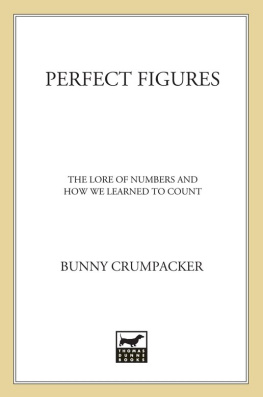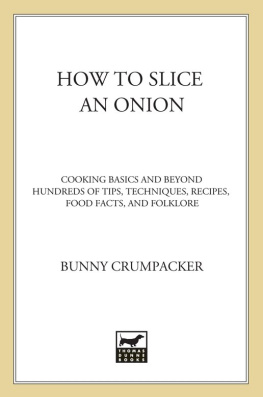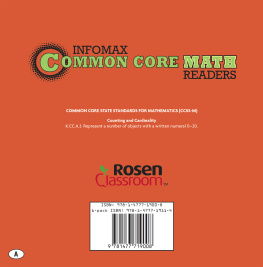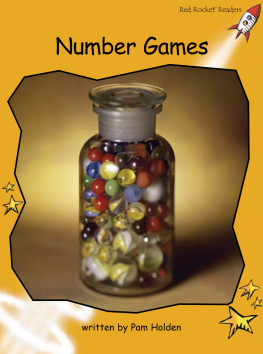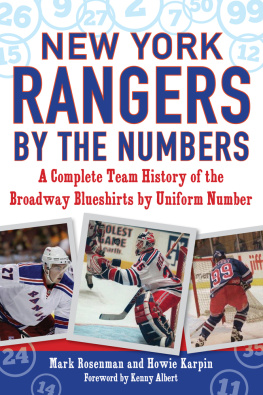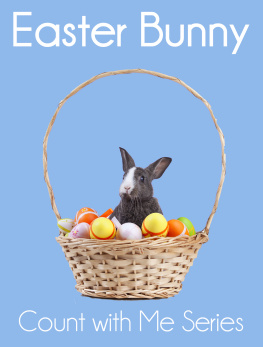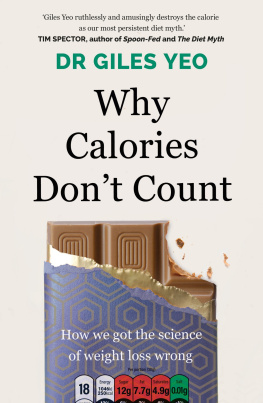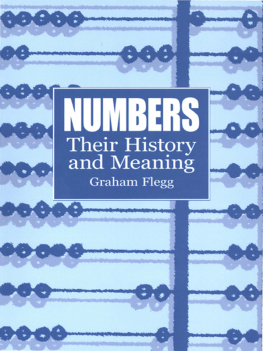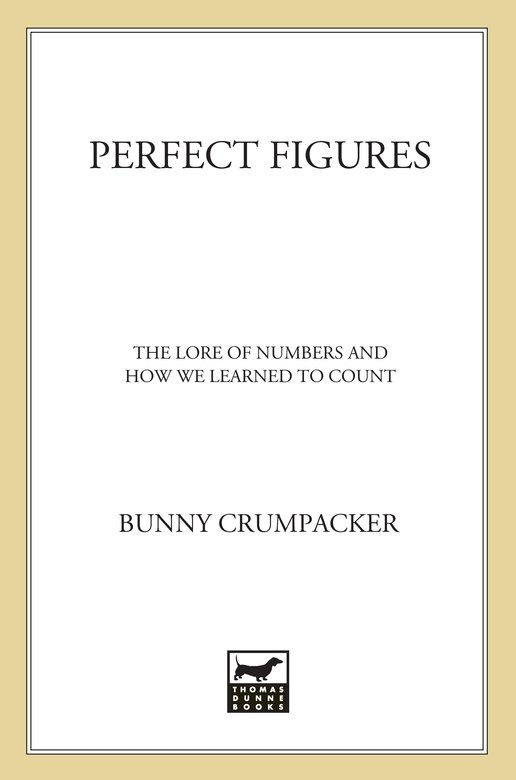Deepest thanks and appreciation to my editor, Peter Joseph, who is insightful, helpful, always of good cheer, and funny too; what a lovely combination! William Wolz read these pages in an early version, and made several helpful suggestions. Im grateful to him, and to Cathy and Michael Wolz for helping me find him. Official thanks are overdue to Toni Plummer and Jess KormanToni for cheery and cool efficiency, and Jess for a host of helpful suggestions. Im grateful for Jan Connors eagle eyes, and to their happy owner as well, for Matt Hintons discerning eye and mind, and to Lee Sennish, Sabine von Aulock, and Robbin Novak. And then there are special thanks for Chick, my own Ramanujan.
Crump, Thomas. The Anthropology of Numbers . Cambridge University Press, Cambridge. 1992.
Dantzig, Tobias. Number: The Language of Science . Macmillan, New York. 1967.
Humez, Alexander, Nicholas Humez, and Joseph Maguire. Zero to Lazy Eight: The Romance of Numbers . Simon & Schuster, New York. 1993.
Ifrah, Georges. From One to Zero, a Universal History of Numbers . Viking, New York. 1985.
The Universal History of Numbers: From Pre-History to the Invention of the Computer . John Wiley & Sons, New York. 2000.
Kaplan, Robert. The Nothing That Is: A Natural History of Zero . Oxford University Press, New York. 2000.
Livio, Mario. The Golden Ratio: The Story of Phi, the Worlds Most Astonishing Number . Broadway Books, New York. 2003.
Menninger, Karl. Number Words and Number Symbols: A Cultural History of Numbers . The MIT Press, Cambridge, MA. 1970.
Schimmel, Annemarie. The Mystery of Numbers . Oxford University Press, New York. 1993.
Smith, David Eugene, and Jekuthiel Ginsburg. Numbers and Numerals . National Council of Teachers of Mathematics, Washington, D.C. 1961.
Wells, David. The Penguin Dictionary of Curious and Interesting Numbers . Penguin Books, London. 1997.
ONE IS ALL
O ne is the beginning, the single starting place. Its the universe at the big bang: There was that enormous event, that unthinkable noise, and suddenly, in a fraction of a second, whatever there washad it been One?had shattered. It became a billion million stars, galaxies after galaxies of stars, stars with planets and moons and meteors and asteroids, each one containing everything again, atoms and molecules, charm and quark, and each thingeach atom, each galaxywas still one, one again. One after one to infinity.
At our own beginning, there were no numbers, not even one. We had no need for numbersno need to count, no need to know how many. Sufficient unto itself, and for our survival, was each person, each thing, each moment.
Very unlike a divine man would he be, who is unable to count one, two, three, or to distinguish odd and even numbers. PLATO
We knew the day, and the darkness that came after the day, night after day and then day after night. But eventually the time must have come when someone wanted to keep track of yesterday, today, and tomorrow, and count what fills those days: moons and meals and springtimes. And eventually, someone wanted to count what was hisanimals, perhaps, or arrows, or seeds, oil, and grain. Perhaps someone wanted to know what was cominghow many days it would be necessary to wait until the floods would come again, or the moon would disappear and then come back, how long before the baby would be born, or how long before the sun returned from its trip to the edge of the world and the cold passed and the days slowly began to grow longer again.
There is an unexpected story in the history of how we learned to countfrom our first recognition of numero uno, the one we mean when we point to ourselves, to the vast numbers we think of when we look at the stars on a moonless night.
Counting is a natural process, almost inevitable, and numbers are organic. They begin with the single line of our bodies, the psychic feel of ourselves. They grow, one by one by one, but they always remain intimately connected to our physical being, from the twoness of our eyes and arms and legs to our ten fingers andshould we need themour ten toes.
The concept of number is the obvious distinction between beast and man. Thanks to number, the cry becomes a song, noise acquires rhythm, the spring is transformed into a dance, force becomes dynamic, and outlines, figures.
JOSEPH DE MAISTRE
Counting is as natural as numbers. We count each other, and then our children, the things we own, the days weve passed through. Numbers count the things of the world, which must have become less untamable as we numbered its parts and learned to give them names. When we drew an animal on the wall of a cave, we made this one, and then that oneone and twoand we gave the animal its name. When we made designs of the stars over our heads and told their stories to each other, we remembered how many stars there are in Orions belt or in Cassiopeias chair. Everywhere, we learned numbers this naturally, and taught ourselves to count, because we always needed to know how many.
Once, we wanted to know how many cattle left in the morning and came home at night, how many seeds it was necessary to save for next years planting, or how many days there were from full moon to full moon. Now we need zip codes and Social Security numbers, phone numbers and license plates. Our passports and our houses are numbered, as are our charge accounts and checks and telephones. Numbers have grown away from the simplicity of you and me and the baby. Now, they define us with increasing complexity, and we lose track of how they began, one by one by onethis one, that one, those, and me, you, and the rest of the world.
In another way, perhaps God taught Adam to count when he crafted Eve from Adams rib and suddenly, where there had been one, lo! there were two. Did Adam and Eve keep track of their children by counting? Did they subtract one from two when Abel disappeared and only Cain was left? Apparently not. But clearly, God could count.
Once we left the garden, learning to count for ourselves was a slow processit took millennia to learn to answer, in all the varied ways, the basic questions of mathematics: how many? how much? Like magic, numbers became visible as we needed to know them. Along the way, people counted in different ways in different placesby twos, fours, fives, twelves, twenties, sixties, and finally, by tens. Everywhere, numbers became part of civilization, and then came to mean more than just the amount they stood forthey meant good luck and bad, wishes and fairy tales, religion and a way of forecasting the future.
Although we learned numbers at different times and places, we always began with one. Here, we used piles of pebbles as equivalents for numbers, and there, we made notches on sticks or bones, but everywhere, even today, men and women have used their fingers to count. We forget how organic numbers arehow they grew out of our bodies as we learned to hold one finger up to mean one, or point to our eyes for two, and to find higher numbers on our fingers and our toes.
It isnt necessary to count the way we do now in order to answer the basic question of how many. Little children can say numbers from one to eleventy and beyond, but they have different ways of telling you how many toys they havethis one and that one and the other one, maybe, or just twenty-teen-two.

